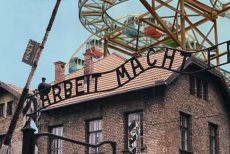
READER: One thing you said in the Zundel interview that I found interesting is that if people were crammed into an airtight space like the so-called gas chambers they would suffocate very quickly so there would be no point in trying to gas them. That's a great point.
ME: It's been suggested to me that to minimize their suffering you could fill the chamber with nitrogen or some gas that contains no oxygen but that wasn't really poisonous. I don't know if that would make any difference. But 2,000 people crammed into 240 square meters? They'd suffocate anyway.
READER: Or maybe something like argon that depletes oxygen. It's the gas used to shield welding from oxygen. You'll die quick just from welding in a confined space, even if it has a good size opening somewhere.
ME: What you told me about argon gas is very important because it is very cheap and it appears that argon gas poisoning is not very painful. Is that true? Suffocation is horrible. There must have been a lot of welding going on at Auschwitz. Is this a new process?
READER: Argon as a shielding gas goes back well before WWII and was utilized on a mass scale pretty much immediately because of its proficiency. It's cheap and much more productive, because you can weld with a constant flow of wire rather than with a stick rod which has its own shield casing but is usually only about 12 inches long and you have to keep throwing them away and grabbing new ones, then you have to clean all of the slag off of the weld which also takes a lot of time.
Stick welding is still used a lot but it depends on what you're doing like maybe hard to reach places or working out in the field where you don't necessarily have or don't want to drag around a big tank of gas. When you consider what was being done in the labor camps they would've have to had been using large amounts of Argon.
I don't know about getting sick off breathing it but it is much heavier than oxygen so it pushes the air up and then you're dead. A room crammed full of people would be toast in no time. You could keep it already half-filled with Argon. It would be no risk for those standing in the wide open air outside the gas room like cyanide would and it wouldn't kill people immediately so you could get them in there first. Pump a little more in they would all pass out dead. Next round.
Death would be relatively painless, I think, but not completely (like carbon monoxide). You would get sick and pass out. Headaches, dizziness, nausea, sleepiness, then death. Slow asphyxiation isn't nearly as painful as hard suffocation, where you lose all oxygen at once like a plastic bag over the head...

Thrill to "Holo-Land"
Fun for the Entire Family
---
---
Wikipedia says:
Although argon is non-toxic, it is 38% denser than air and is therefore considered a dangerous asphyxiant in closed areas. It is also difficult to detect because it is colorless, odorless, and tasteless. A 1994 incident in which a man was asphyxiated after entering an argon-filled section of oil pipe under construction in Alaska highlights the dangers of argon tank leakage in confined spaces, and emphasizes the need for proper use, storage and handling...